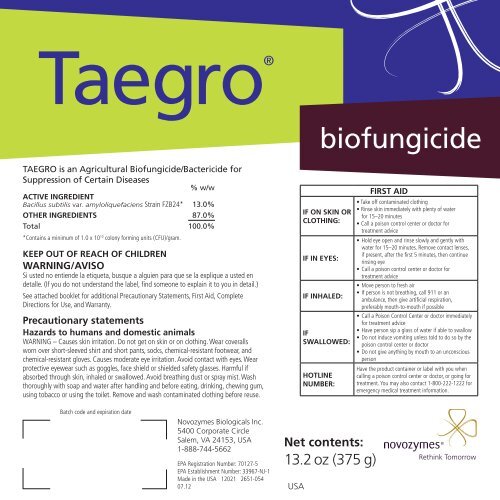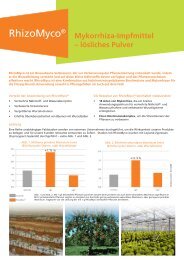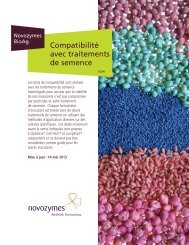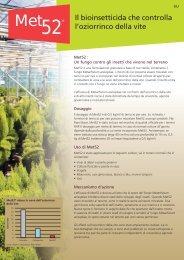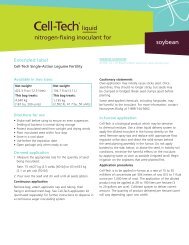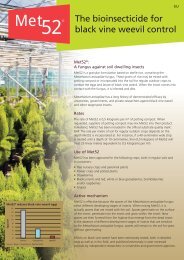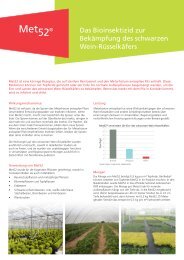Taegro label - Novozymes
Taegro label - Novozymes
Taegro label - Novozymes
Create successful ePaper yourself
Turn your PDF publications into a flip-book with our unique Google optimized e-Paper software.
% w/w<br />
ACTIVE INGREDIENT<br />
Bacillus subtilis var. amyloliquefaciens Strain FZB24* 13.0%<br />
OTHER INGREDIENTS 87.0%<br />
Total 100.0%<br />
*Contains a minimum of 1.0 x 10 10 TAEGRO is an Agricultural Biofungicide/Bactericide for<br />
Suppression of Certain Diseases<br />
colony forming units (CFU)/gram.<br />
kEEP OuT OF REACH OF CHIlDREN<br />
wARNING/AVISO<br />
Si usted no entiende la etiqueta, busque a alguien para que se la explique a usted en<br />
detalle. (If you do not understand the <strong>label</strong>, find someone to explain it to you in detail.)<br />
See attached booklet for additional Precautionary Statements, First Aid, Complete<br />
Directions for Use, and Warranty.<br />
Precautionary statements<br />
Hazards to humans and domestic animals<br />
WARNING – Causes skin irritation. Do not get on skin or on clothing. Wear coveralls<br />
worn over short-sleeved shirt and short pants, socks, chemical-resistant footwear, and<br />
chemical-resistant gloves. Causes moderate eye irritation. Avoid contact with eyes. Wear<br />
protective eyewear such as goggles, face shield or shielded safety glasses. Harmful if<br />
absorbed through skin, inhaled or swallowed. Avoid breathing dust or spray mist. Wash<br />
thoroughly with soap and water after handling and before eating, drinking, chewing gum,<br />
using tobacco or using the toilet. Remove and wash contaminated clothing before reuse.<br />
Batch code and expiration date<br />
<strong>Novozymes</strong> Biologicals Inc.<br />
5400 Corporate Circle<br />
Salem, VA 24153, USA<br />
1-888-744-5662<br />
EPA Registration Number: 70127-5<br />
EPA Establishment Number: 33967-NJ-1<br />
Made in the USA 12021 2651-054<br />
07.12<br />
biofungicide<br />
IF ON SkIN OR<br />
ClOTHING:<br />
IF IN EyES:<br />
IF INHAlED:<br />
IF<br />
SwAllOwED:<br />
HOTlINE<br />
NumbER:<br />
Net contents:<br />
13.2 oz (375 g)<br />
USA<br />
FIRST AID<br />
• Take off contaminated clothing<br />
• Rinse skin immediately with plenty of water<br />
for 15–20 minutes<br />
• Call a poison control center or doctor for<br />
treatment advice<br />
• Hold eye open and rinse slowly and gently with<br />
water for 15–20 minutes. Remove contact lenses,<br />
if present, after the first 5 minutes, then continue<br />
rinsing eye<br />
• Call a poison control center or doctor for<br />
treatment advice<br />
• Move person to fresh air<br />
• If person is not breathing, call 911 or an<br />
ambulance, then give artificial respiration,<br />
preferably mouth-to-mouth if possible<br />
• Call a Poison Control Center or doctor immediately<br />
for treatment advice<br />
• Have person sip a glass of water if able to swallow<br />
• Do not induce vomiting unless told to do so by the<br />
poison control center or doctor<br />
• Do not give anything by mouth to an unconscious<br />
person<br />
Have the product container or <strong>label</strong> with you when<br />
calling a poison control center or doctor, or going for<br />
treatment. You may also contact 1-800-222-1222 for<br />
emergency medical treatment information.
Personal protective equipment (PPE)<br />
Applicators and other handlers must wear:<br />
• Coveralls worn over short-sleeved shirt and short pants<br />
• Socks<br />
• Chemical-resistant footwear<br />
• Chemical-resistant gloves<br />
• Protective eyewear such as goggles, face shield or shielded safety glasses<br />
Mixers/loaders and applicators must wear a dust/mist filtering respirator<br />
meeting NIOSH standards of at least N-95, R-95, or P-95. Repeated exposure<br />
to high concentrations of microbial proteins can cause allergic sensitization.<br />
When mixing and loading, wear a chemical-resistant apron. When cleaning<br />
equipment, wear a chemical resistant apron.<br />
Follow manufacturer’s instructions for cleaning/maintaining PPE. If no such<br />
instructions for washables exist, use detergent and hot water. Keep and wash<br />
PPE separately from other laundry.<br />
Engineering controls<br />
When handlers use closed systems or enclosed cabs in a manner that<br />
meets the requirements listed in the Worker Protection Standard (WPS) for<br />
agricultural pesticides [40 CFR 170.240(d)(4-6)] the handler PPE requirements<br />
may be reduced or modified as specified in the WPS.<br />
IMPORTANT: When reduced PPE is worn because a closed system is being<br />
used, handlers must be provided all PPE specified above for “applicators<br />
and other handlers” and have such PPE immediately available for use in an<br />
emergency, such as a spill or equipment breakdown.<br />
user safety recommendations<br />
Users should:<br />
• Remove clothing/PPE immediately if pesticide gets inside. Then wash<br />
thoroughly and put on clean clothing<br />
• Remove PPE immediately after handling this product. Wash the outside<br />
of gloves before removing. As soon as possible, wash thoroughly and<br />
change into clean clothing<br />
Environmental hazards<br />
For terrestrial uses: Do not apply directly to water, or to areas where surface<br />
water is present, or to intertidal areas below the mean high water mark.<br />
Do not contaminate water when cleaning equipment or disposing of<br />
equipment wash waters or rinsate.<br />
Physical or chemical hazards<br />
For spill, leak, fire, exposure, or accident call CHEMTREC at 1-800-424-9300.<br />
Directions for use<br />
It is a violation of Federal law to use this product in a manner inconsistent<br />
with its <strong>label</strong>ing.<br />
Do not apply this product in a way that will contact workers or other persons,<br />
either directly or through drift. Only protected handlers may be in the area<br />
during application. For any requirements specific to your State or Tribe, consult<br />
the state or tribal agency responsible for pesticide regulation.<br />
Not for sale, use or distribution in Hawaii.<br />
Agricultural use requirements<br />
Use this product only in accordance with its <strong>label</strong>ing and with the Worker<br />
Protection Standard, 40 CFR part 170. This Standard contains requirements<br />
for the protection of agricultural workers on farms, forests, nurseries<br />
and greenhouses, and handlers of agricultural pesticides. It contains<br />
requirements for training, decontamination, notification, and emergency<br />
assistance. It also contains specific instructions and exceptions pertaining<br />
to the statements on this <strong>label</strong> about personal protective equipment (PPE)<br />
and restricted-entry interval. The requirements in this box only apply to uses<br />
of this product that are covered by the Worker Protection Standard.<br />
Do not enter or allow worker entry into treated areas during the<br />
restricted-entry interval (REI) of 24 hours.<br />
EXCEPTION: If the product is soil-incorporated, the Worker Protection<br />
Standard, under certain circumstances, allows workers to enter the treated<br />
area if there will be no contact with anything that has been treated.<br />
For early entry into treated areas that is permitted under the Worker<br />
Protection Standard and that involves contact with anything that has been<br />
treated, such as plants, soil, or water, wear:<br />
• Coveralls worn over short-sleeved shirt and short pants<br />
• Socks<br />
• Chemical-resistant footwear<br />
• Chemical-resistant gloves<br />
• Protective eyewear such as goggles, face shield or shielded<br />
safety glasses<br />
Non-agricultural use requirements<br />
The requirements in this box apply to uses that are NOT within the scope<br />
of the Worker Protection Standard for agricultural pesticides (40 CFR Part<br />
170). The WPS applies when this product is used to produce agricultural<br />
plants on farms, forests, nurseries or greenhouses.<br />
Keep unprotected persons out of treated areas until spray has dried.<br />
General<br />
TAEGRO is a bacterial based biofungicide/bactericide used for suppressing<br />
selected soil-borne and foliar diseases on agricultural and ornamental crops as<br />
listed on the following pages.<br />
TAEGRO is most effective in low to medium disease pressure situations and<br />
should be applied prior to disease or at disease establishment so suppression<br />
action is maximized. Use TAEGRO on the following agricultural crops grown<br />
outdoors and in greenhouses:
Soil Injected, Sprayed, or Incorporated use Recommendations:<br />
Crop Diseases Rate (Oz/<br />
Acre)<br />
Leafy<br />
Vegetables:<br />
Head/Leaf<br />
Lettuce<br />
Celery<br />
Spinach<br />
Radicchio<br />
Endive<br />
Arugula<br />
Mache<br />
Parsley<br />
Rhubarb<br />
Swiss Chard<br />
Fruiting<br />
Vegetables:<br />
Tomato<br />
Rhizoctonia<br />
Fusarium<br />
2.6 - 5.2 oz<br />
Sclerotinia 2.6 - 5.2 oz<br />
Use Recommendations<br />
• Apply at planting or immediately following through overhead sprinkler, drip injection, in-furrow soil spray or<br />
with liquid fertilizer at planting<br />
• Follow with sprinkler, basal sprays or drip injection every 7-14 days as needed through the season. When<br />
using basal spray incorporate by following with irrigation to soak root zone<br />
• Fields with historical Rhizoctonia and Fusarium problems may require more applications and shorter<br />
frequency for better efficacy<br />
• Apply at planting (seeded or transplanting) or immediately following planting as a soil spray (in-furrow with<br />
the seed, drip (buried, surface) or with liquid fertilizer applied at planting<br />
• Sequential applications should initiate at lettuce thinning and continue every 7-14 days depending on<br />
disease pressure<br />
• Applications for S. minor control should be applied to the root zone for optimum protection with in-furrow<br />
and drip applications as the best methods to get TAEGRO into the root zone<br />
• A combination of applications for S. sclerotiorum control should be drip, soil surface applications and foliar<br />
applications at infestation sites (dead or dying tissue) for optimum control<br />
• Fields with historical Sclerotinia problems may require a higher rate, more applications, and shorter<br />
application intervals for better efficacy<br />
Rhizoctonia 2.6 - 5.2 oz • Apply as drench on transplants prior to planting<br />
Fusarium 2.6 - 5.2 oz<br />
Phythophthora 2.6 - 5.2 oz<br />
Pythium 2.6 - 5.2 oz<br />
Peppers Phythophthora 2.6 - 5.2 oz<br />
Cucurbits:<br />
Cantaloupe<br />
Honey Dew<br />
Cucumber<br />
Squash<br />
Watermelon<br />
Pythium 2.6 - 5.2 oz<br />
Rhizoctonia<br />
Fusarium<br />
Phythophthora<br />
Pythium<br />
2.6 - 5.2 oz<br />
• Apply w/liquid fertilizer or as an in-furrow soil spray or drip irrigation injection at or immediately following<br />
planting<br />
• Follow with drip injection or basal sprays every 7-14 days as needed through the season. When using basal<br />
spray incorporate by following with irrigation to soak root zone<br />
• Fields with historical Rhizoctonia, Fusarium, Phytophthora and Pythium problems may require more<br />
applications and shorter frequency for better efficacy<br />
• Apply as drench on transplants prior to planting<br />
• Apply at planting or immediately following planting as an in-furrow soil spray or with liquid fertilizer<br />
• Follow with drip irrigation or basal sprays every 7-14 days as needed through the season. When using basal<br />
spray incorporate by following with irrigation to soak root zone<br />
• Fields with historical Rhizoctonia, Fusarium, Phytophthora and Pythium problems may require more<br />
applications and shorter frequency for better efficacy
Crop Diseases Rate (Oz/<br />
100 Gal)<br />
Ornamentals: Rhizoctonia<br />
Fusarium<br />
Phythophthora<br />
Pythium<br />
Foliar use Recommendations:<br />
2.6 - 5.2 oz<br />
Crop Diseases Rate (Oz/<br />
Acre)<br />
Leafy<br />
Vegetables:<br />
Lettuce<br />
Celery<br />
Spinach<br />
Radicchio<br />
Endive<br />
Arugula<br />
Mache<br />
Parsley<br />
Rhubarb<br />
Swiss Chard<br />
Fruiting<br />
Vegetable:<br />
Tomato<br />
Downy Mildew 2.6 - 5.2 oz<br />
Powdery<br />
Mildew<br />
2.6 - 5.2 oz<br />
Early Blight 2.6 - 5.2 oz<br />
Late Blight 2.6 - 5.2 oz<br />
Bacterial<br />
Speck –<br />
Pseudomonas<br />
Bacterial<br />
Spot –<br />
Xanthomonas<br />
2.6 - 5.2 oz<br />
2.6 - 5.2 oz<br />
Use Recommendations<br />
• Apply enough solution to thoroughly soak the root zone in growing media<br />
• Start applications prior to disease or at disease establishment. Apply every 7-14 days alone or in rotation, or<br />
tank mix with other registered fungicides<br />
Use Recommendations<br />
• Start applications prior to disease or at disease establishment. Apply every 7-14 days alone or in rotation, or<br />
tank mix with other registered fungicides<br />
• Apply enough spray solution for thorough coverage and the addition of a non-ionic surfactant may improve<br />
disease control<br />
• Start applications prior to disease or at disease establishment. Apply every 7-14 days alone or in rotation, or<br />
tank mix with other registered fungicides<br />
• Apply enough spray solution for thorough coverage and the addition of a non-ionic surfactant may improve<br />
disease control
Crop Diseases Rate (Oz/<br />
Acre)<br />
Fruiting<br />
Vegetable:<br />
Pepper<br />
Cucurbits:<br />
Cantaloupe<br />
Honey Dew<br />
Cucumber<br />
Squash<br />
Watermelon<br />
Bacterial<br />
Spot –<br />
Xanthomonas<br />
Powdery<br />
Mildew<br />
Powdery<br />
Mildew<br />
2.6 - 5.2 oz<br />
2.6 - 5.2 oz<br />
2.6 - 5.2 oz<br />
Use Recommendations<br />
mixing instructions<br />
TAEGRO must be pre-mixed thoroughly with water to assure a properly<br />
distributed suspension. Mix the necessary amount of TAEGRO with three<br />
quarters of the water needed to reach final volume. If mix water pH is<br />
less than 5 or greater than 8, pH adjustment and buffering may improve<br />
suspension. Begin agitation or mixing before metering TAEGRO into the<br />
suspension. When the suspension is thoroughly mixed, add the remaining<br />
water. For best results, agitate final suspension immediately before application<br />
to ensure complete and even suspension of product. Apply content of entire<br />
suspension within a few hours of mixing to ensure viability of TAEGRO.<br />
Compatibility<br />
TAEGRO is compatible with many commonly used plant protection products<br />
and fertilizers, but has not been evaluated with all potential combinations of<br />
products that might be in tank mixes. To ensure compatibility, conduct a jar<br />
test by mixing proportionally scaled down quantities of the desired tank mix<br />
components in proportional amount of water. Add powders and granules first<br />
followed by suspensions and liquids. Let the mix sit for 5-10 minutes. If the mix<br />
stays in solution or re-suspends, it is physically compatible. If possible, spray the<br />
jar mix on a small section of crop to confirm crop safety of the mix.<br />
Application instructions<br />
Apply TAEGRO as early as possible in the life cycle of the plant to enhance<br />
disease protection. Apply TAEGRO to plants according to use patterns by<br />
disease, crop, and disease pressure as needed for up to 12 applications<br />
per season. For best results, initiate TAEGRO applications prior to disease<br />
establishment while the disease pressure is low to medium. When diseases<br />
• Start applications prior to disease or at disease establishment. Apply every 7-14 days alone or in rotation, or<br />
tank mix with other registered fungicides<br />
• Apply enough spray solution for thorough coverage and the addition of a non-ionic surfactant may improve<br />
disease control<br />
• Start applications prior to disease or at disease establishment. Apply every 7-14 days alone or in rotation, or<br />
tank mix with other registered fungicides<br />
• Apply enough spray solution for thorough coverage and the addition of a non-ionic surfactant may improve<br />
disease control<br />
reach medium to high pressure, TAEGRO is most effective in tank mixes or<br />
rotations with other fungicides as an excellent resistance management tool.<br />
Transplants, including plugs – Apply TAEGRO to transplants by<br />
dipping or drenching, making sure the root system is thoroughly soaked. For<br />
dipping, follow the instructions for “Cutting and Root Dips” before planting<br />
transplants into soil medium. For drenching, first plant the transplants into<br />
soil medium and then follow instructions for “Drenching.” In greenhouse<br />
production apply TAEGRO to newly sown transplants.<br />
Drenching – Apply TAEGRO to seedlings or newly rooted cuttings. Drench<br />
soil around plants with the TAEGRO suspension making sure TAEGRO is<br />
thoroughly drenched into the root zone.<br />
Mix and apply TAEGRO as follows:<br />
• Per 100 gallons of water – By weight use 75-150 grams (2.6 - 5.2 oz) of<br />
TAEGRO; By volume, use 3.5-7.0 fluid ounces of TAEGRO<br />
• Per 1 gallon of water – By weight use 1.5 grams (0.05 oz) of TAEGRO.<br />
Cutting and root dips: Stir suspension for several minutes to ensure<br />
complete mixture and to eliminate clumps. Place rootstock in the suspension<br />
for 5-10 minutes allowing time for TAEGRO to penetrate the root zone. For<br />
ornamentals, apply at least one follow up drench treatment two to three<br />
weeks following initial treatment.<br />
Mix and apply TAEGRO as follows:<br />
• Per 1 gallon of water – By weight use 8 grams (0.28 oz) of TAEGRO; By<br />
volume, use 2 teaspoons of TAEGRO.
Row crops: TAEGRO should be applied in an application volume that<br />
provides adequate coverage and placement for optimum crop protection and<br />
disease prevention. Application rates of 2.6 - 5.2 oz per acre in 20-50 gallons<br />
per acre should be used for low biomass crops to provide optimum coverage.<br />
Foliar disease control on high biomass crops and crop stages and soil<br />
drench applications should be made at 2.6 - 5.2 oz per 100 gallons at total<br />
applications volumes that provide optimum coverage and disease protection.<br />
Seed treatments: Using the table below, apply the specified amount of<br />
TAEGRO into specified amount of water and apply to the seed per your usual<br />
seed treatment method.<br />
Seed TAeGRO/seed Water/seed<br />
oz<br />
TAeGRO/<br />
lb seed<br />
g<br />
TAeGRO /<br />
kg seed<br />
oz water/<br />
lb seed<br />
fluid ml<br />
water/kg<br />
seed<br />
Beet 0.54 15.30 0.47 30.6<br />
Canola 0.96 27.25 0.84 54.5<br />
Corn 0.40 11.34 0.58 37.8<br />
Cotton 0.67 18.90 0.58 37.8<br />
Cucumber 0.96 27.25 0.84 54.5<br />
Garden Bean 0.05 1.40 0.09 5.6<br />
Lettuce –<br />
Pelletized<br />
Lettuce –<br />
Unpelletized<br />
0.93 26.45 0.81 52.9<br />
0.58 16.45 0.50 32.9<br />
Onion 1.44 40.90 1.25 81.8<br />
Pepper 0.96 27.25 0.84 54.5<br />
Soy 0.06 1.55 0.12 7.75<br />
Tomato 1.44 40.90 1.25 81.8<br />
Wheat 0.07 1.92 0.10 6.4<br />
Do not use treated seed for food or feed purposes or process for oil. Treat<br />
only those seeds needed for immediate use, minimizing the interval between<br />
treatments and planting. Do not store excess treated seeds beyond planting<br />
time.<br />
Soil Incorporation: Mix TAEGRO into soil or soilless growing media at<br />
a rate of 8.8 oz (250 grams) per cubic yard. Thoroughly mix media, using<br />
mechanical mixing equipment, to ensure a uniform distribution of product.<br />
Incorporated into soil, TAEGRO can be raked into growing beds prior to<br />
planting.<br />
Hydroponics: Prepare a stock solution by adding 1 gram (¼ teaspoon)<br />
of TAEGRO, for every 50 feet of irrigation tubing, in one gallon of water. Stir<br />
product for several minutes to ensure complete suspension. Add solution to<br />
circulating water system and allow to go through three to five watering cycles<br />
before clearing the system. For best results, make two or three applications<br />
spaced one week apart.<br />
Chemigation<br />
General requirements<br />
Apply this product through overhead sprinkler irrigation systems including<br />
center pivot, lateral move, end tow, side (wheel) roll, traveler, big gun, solid<br />
set, or hand move; flood (basin); furrow; border or drip (buried or surface<br />
placed) irrigation systems. Do not apply this product through any other type<br />
of irrigation system.<br />
Crop injury, inconsistent results, or excessive residues can result from<br />
non-uniform applications that have not been adequately mixed and applied<br />
through equipment that has been properly calibrated.<br />
A good source for answers if you have questions about calibration is your<br />
local State Cooperative Extension Service specialists, equipment manufacturers<br />
or university calibration guides.<br />
Do not connect an irrigation system (including greenhouse systems) used<br />
for pesticide application to a public water system unless the pesticide <strong>label</strong>prescribed<br />
safety devices for public water systems are in place.<br />
A person knowledgeable of the chemigation system and responsible for its<br />
operation or under the supervision of the responsible person shall shut the<br />
system down and make necessary adjustments should the need arise.<br />
General Instructions for use of TAEGRO in Chemigation<br />
Mixing and Application Instructions: A pesticide supply tank is recommended.<br />
Fill supply tank with water to approximately one-half of the desired volume<br />
and add TAEGRO, mixing while pouring in TAEGRO. Fill the supply tank to the<br />
desired volume. Continuous agitation of TAEGRO in the supply tank is required<br />
to achieve optimum coverage and crop protection.<br />
Mix 75-150 grams (2.6 - 5.2 oz) of TAEGRO in 100 gallons of water. Use<br />
irrigation levels of 0.2 to 0.5 inches of water per acre as a guideline,<br />
but additional irrigation volumes may be required for optimum coverage<br />
depending on soil texture and soil moisture levels at the time of application.<br />
The irrigation system should be purged prior to injecting TAEGRO. Once the<br />
targeted application has been completed, flush the system thoroughly with<br />
nontreated water.<br />
Compatibility: If TAEGRO is applied in combination with other pesticides,<br />
determine compatibility prior to application through the irrigation system.<br />
Pour the products into a small container of water in the correct proportions
and mix. Let stand for 10 minutes and if the product combination remains<br />
mixed or can easily be remixed, the mixture is compatible. Observe the most<br />
restrictive of the <strong>label</strong>ing limitations and precautions of all products used in<br />
mixtures. Do not exceed <strong>label</strong> dosage rates. This product cannot be mixed<br />
with any product containing a <strong>label</strong> prohibition against such mixing. Test the<br />
combination on a small portion of the crop to be treated to ensure that a<br />
phyto-toxic response will not occur as a result of application.<br />
Requirements for Chemigation Systems Connected to Public<br />
water Systems<br />
1) Public water system means a system for the provision to the public of<br />
piped water for human consumption if such system has at least 15 service<br />
connections or regularly serves an average of at least 25 individuals daily at<br />
least 60 days out of the year.<br />
2) Chemigation systems connected to public water systems must contain<br />
a functional, reduced-pressure zone (RPZ), back flow preventer or the<br />
functional equivalent in the water supply line upstream from the point of<br />
pesticide introduction. As an option to the RPZ, the water from the public<br />
water system should be discharged into a reservoir tank prior to pesticide<br />
introduction. There shall be a complete physical break (air gap) between the<br />
flow outlet end of the fill pipe and the top or overflow rim of the reservoir<br />
tank of at least twice the inside diameter of the fill pipe.<br />
3) The pesticide injection pipeline must contain a functional, automatic, quickclosing<br />
check valve to prevent the flow of fluid back toward the injection.<br />
4) The pesticide injection pipeline must contain a functional, normally<br />
closed, solenoid-operated valve located on the intake side of the injection<br />
pump and connected to the system interlock to prevent fluid from being<br />
withdrawn from the supply tank when the irrigation system is either<br />
automatically or manually shut down.<br />
5) The system must contain functional interlocking controls to automatically<br />
shut off the pesticide injection pump when the water pump motor stops or<br />
in cases where there is no water pump, when the water pressure decreases<br />
to the point where pesticide distribution is adversely affected.<br />
6) Systems must use a metering pump, such as a positive displacement<br />
injection pump (e.g., diaphragm pump) effectively designed and constructed<br />
of materials that are compatible with pesticides and capable of being fitted<br />
with a system interlock.<br />
7) Do not apply when wind speed favors drift beyond the area intended for<br />
treatment.<br />
Requirements for Sprinkler Chemigation<br />
1) The system must contain a functional check valve, vacuum relief valve,<br />
and low pressure drain appropriately located on the irrigation pipeline to<br />
prevent water source contamination from back flow.<br />
2) The pesticide injection pipeline must contain a functional, automatic,<br />
quick-closing check valve to prevent the flow of fluid back toward the<br />
injection pump.<br />
3) The pesticide injection pipeline must also contain a functional, normally<br />
closed, solenoid-operated valve located on the intake side of the injection<br />
pump and connected to the system interlock to prevent fluid from being<br />
withdrawn from the supply tank when the irrigation system is either<br />
automatically or manually shut down.<br />
4) The system must contain functional interlocking controls to automatically<br />
shut off the pesticide injection pump when the water pump motor stops.<br />
5) The irrigation line or water pump must include a functional pressure switch<br />
which will stop the water pump motor when the water pressure decreases<br />
to the point where pesticide distribution is adversely affected.<br />
6) Systems must use a metering pump, such as a positive displacement<br />
injection pump (e.g., diaphragm pump), effectively designed and<br />
constructed of materials that are compatible with pesticides and capable of<br />
being fitted with a system interlock.<br />
7) Do not apply when wind speed favors drift beyond the area intended for<br />
treatment.<br />
Requirements for Flood (basin), Furrow, and border<br />
Chemigation<br />
1) Systems using a gravity flow pesticide dispensing system must meter the<br />
pesticide into the water at the head of the field and downstream of a<br />
hydraulic discontinuity such as a drop structure or weir box to decrease<br />
potential for water source contamination from back flow if water flow<br />
stops.<br />
2) Systems utilizing a pressurized water and pesticide injection system must<br />
meet the following requirements:<br />
a. The system must contain a functional check valve, vacuum relief valve,<br />
and low pressure drain appropriately located on the irrigation pipeline<br />
to prevent water source contamination from back flow.<br />
b. The pesticide injection pipeline must contain a functional, automatic,<br />
quick-closing check valve to prevent the flow of fluid back toward the<br />
injection pump.<br />
c. The pesticide injection pipeline must also contain a functional, normally<br />
closed, solenoid-operated valve located on the intake side of the<br />
injection pump and connected to the system interlock to prevent fluid<br />
from being withdrawn from the supply tank when the irrigation system<br />
is either automatically or manually shut down.<br />
d. The system must contain functional interlocking controls to<br />
automatically shut off the pesticide injection pump when the water<br />
pump motor stops.<br />
e. The irrigation line or water pump must include a functional pressure<br />
switch which will stop the water pump motor when the water pressure<br />
decreases to the point where pesticide distribution is adversely affected.
f. Systems must use a metering pump, such as a positive displacement<br />
injection pump (e.g., diaphragm pump) effectively designed and<br />
constructed of materials that are compatible with pesticides and capable<br />
of being fitted with a system interlock.<br />
Requirements for Drip (Trickle) Chemigation<br />
1) The system must contain a functional check valve, vacuum relief valve<br />
and low pressure drain appropriately located on the irrigation pipeline to<br />
prevent water source contamination from back flow.<br />
2) The pesticide injection pipeline must contain a functional, automatic,<br />
quick-closing check valve to prevent the flow of fluid back toward the<br />
injection pump.<br />
3) The pesticide injection pipeline must also contain a functional, normally<br />
closed, solenoid-operated valve located on the intake side of the injection<br />
pump and connected to the system interlock to prevent fluid from being<br />
withdrawn from the supply tank when the irrigation system is either<br />
automatically or manually shut down.<br />
4) The system must contain functional inter-locking controls to automatically<br />
shut off the pesticide injection pump when the water pump motor stops.<br />
5) The irrigation line or water pump must include a functional pressure<br />
switch which will stop the water pump motor when the water pressure<br />
decreases to the point where pesticide distribution is adversely affected.<br />
6) Systems must use a metering pump, such as a positive displacement<br />
injection pump (e.g., diaphragm pump), effectively designed and<br />
constructed of materials that are compatible with pesticides and capable<br />
of being fitted with a system interlock.<br />
® <strong>Taegro</strong> is a registered trademark of <strong>Novozymes</strong> A/S. © 2012 <strong>Novozymes</strong>. All rights reserved. 12021 07.12<br />
Storage and disposal<br />
Do not contaminate water, food, or feed by storage or disposal.<br />
Pesticide storage<br />
<strong>Taegro</strong> consists of living microbes. Store at room temperature and use<br />
before the expiry date. Avoid temperatures exceeding 73°F (23°C). Do not<br />
freeze. Close opened packages tightly.<br />
Pesticide disposal<br />
To avoid wastes, use all material in this container by application according<br />
to <strong>label</strong> directions. If wastes cannot be avoided, offer remaining product<br />
to a waste disposal facility or pesticide disposal program (often such<br />
programs are run by state or local governments or by industry).<br />
Container disposal<br />
Non-refillable container. Do not reuse or refill this container. Completely<br />
empty bag into application equipment by shaking and tapping sides and<br />
bottom to loosen clinging particles. Then offer for recycling, if available, or<br />
dispose of empty bag in a sanitary landfill or by incineration. Do not burn<br />
unless allowed by state and local ordinances.<br />
wARRANTy<br />
The Directions for Use of this product reflect the opinion of experts based<br />
on field use and tests. The directions are believed to be reliable and must be<br />
followed carefully. <strong>Novozymes</strong> Biologicals warrants that at the time of the first<br />
sale of this product it conforms to the chemical description on the <strong>label</strong> and<br />
when used according to the <strong>label</strong> directions under normal growing conditions<br />
is reasonably fit for the purposes referred to above. Buyers/Users of this<br />
product assume full risk for any use contrary to the specified directions. If this<br />
product does not perform as warranted above and to the extent consistent<br />
with applicable law, customer’s sole remedy for breach of warranty shall be<br />
replacement of the product or refund of the purchase price paid, at the option<br />
of <strong>Novozymes</strong> Biologicals.<br />
EXCEPT AS PROVIDED ELSEWHERE IN WRITING CONTAINING AN EXPRESSED<br />
REFERENCE TO THIS WARRANTY AND LIMITATION OF DAMAGES, SELLER<br />
MAKES NO OTHER EXPRESSED OR IMPLIED WARRANTY OR GUARANTEE TO<br />
THE EXTENT CONSISTENT WITH APPLICABLE LAW, INCLUDING ANY OTHER<br />
EXPRESSED OR IMPLIED WARRANTY OF FITNESS OR OF MERCHANTABILITY,<br />
AND NO AGENT OF SELLER IS AUTHORIZED TO DO SO.
TAEGRO is an Agricultural Biofungicide/<br />
Bactericide for Suppression of Certain Diseases<br />
% w/w<br />
ACTIVE INGREDIENT<br />
Bacillus subtilis var. amyloliquefaciens Strain FZB24* 13.0%<br />
OTHER INGREDIENTS 87.0%<br />
Total 100.0%<br />
*Contains a minimum of 1.0 x 10 10 colony forming units (CFU)/gram.<br />
kEEP OuT OF REACH OF CHIlDREN<br />
wARNING/AVISO<br />
Si usted no entiende la etiqueta, busque a alguien para que se la<br />
explique a usted en detalle. (If you do not understand the <strong>label</strong>, find<br />
someone to explain it to you in detail.)<br />
See attached booklet for additional Precautionary Statements, First Aid,<br />
Complete Directions for Use, and Warranty.<br />
Precautionary statements<br />
Hazards to humans and domestic animals<br />
WARNING – Causes skin irritation. Do not get on skin or on<br />
clothing. Wear coveralls worn over short-sleeved shirt and short<br />
pants, socks, chemical-resistant footwear, and chemical-resistant<br />
gloves. Causes moderate eye irritation. Avoid contact with eyes.<br />
Wear protective eyewear such as goggles, face shield or shielded<br />
safety glasses. Harmful if absorbed through skin, inhaled or<br />
swallowed. Avoid breathing dust or spray mist. Wash<br />
thoroughly with soap and water after handling and<br />
before eating, drinking, chewing gum, using tobacco<br />
or using the toilet. Remove and wash contaminated<br />
clothing before reuse.<br />
Batch code and expiration date<br />
IF ON SkIN OR<br />
ClOTHING:<br />
IF IN EyES:<br />
IF INHAlED:<br />
IF<br />
SwAllOwED:<br />
HOTlINE<br />
NumbER:<br />
<strong>Novozymes</strong> Biologicals Inc.<br />
5400 Corporate Circle<br />
Salem, VA 24153, USA<br />
1-888-744-5662<br />
EPA Registration Number: 70127-5<br />
EPA Establishment Number: 33967-NJ-1<br />
Made in the USA 12021 2651-054<br />
07.12<br />
FIRST AID<br />
biofungicide<br />
• Take off contaminated clothing<br />
• Rinse skin immediately with plenty<br />
of water<br />
for 15–20 minutes<br />
• Call a poison control center or doctor for<br />
treatment advice<br />
• Hold eye open and rinse slowly and gently<br />
with water for 15–20 minutes. Remove<br />
contact lenses, if present, after the first 5<br />
minutes, then continue rinsing eye<br />
• Call a poison control center or doctor for<br />
treatment advice<br />
• Move person to fresh air<br />
• If person is not breathing, call 911 or an<br />
ambulance, then give artificial respiration,<br />
preferably mouth-to-mouth if possible<br />
• Call a Poison Control Center or doctor<br />
immediately for treatment advice<br />
• Have person sip a glass of water if able to<br />
swallow<br />
• Do not induce vomiting unless told to do<br />
so by the poison control center or doctor<br />
• Do not give anything by mouth to an<br />
unconscious person<br />
Have the product container or <strong>label</strong> with<br />
you when calling a poison control center or<br />
doctor, or going for treatment. You may also<br />
contact 1-800-222-1222 for emergency<br />
medical treatment information.<br />
Net contents:<br />
13.2 oz (375 g)<br />
USA<br />
Storage and disposal<br />
Do not contaminate water, food, or feed<br />
by storage or disposal.<br />
Pesticide storage<br />
<strong>Taegro</strong> consists of living microbes. Store<br />
at room temperature and use before<br />
the expiry date. Avoid temperatures<br />
exceeding 73°F (23°C), Do not freeze.<br />
Close opened packages tightly.<br />
Pesticide disposal<br />
To avoid wastes, use all material in this<br />
container by application according to<br />
<strong>label</strong> directions. If wastes cannot be<br />
avoided, offer remaining product to<br />
a waste disposal facility or pesticide<br />
disposal program (often such programs<br />
are run by state or local governments or<br />
by industry).<br />
Container disposal<br />
Non-refillable container. Do not reuse or<br />
refill this container. Completely empty<br />
bag into application equipment by<br />
shaking and tapping sides and bottom<br />
to loosen clinging particles. Then offer<br />
for recycling, if available, or dispose of<br />
empty bag in a sanitary landfill or by<br />
incineration. Do not burn unless allowed<br />
by state and local ordinances.


